PART 1
MUCHMUSIC: THEN AND NOW

Fans attending a show at MuchMusic's former headquarters on Queen Street West.
📸: Provided by Bell Media.

STEPHANIE BAI
Soon-to-be graduate of the University of Toronto who writes about cultural and social intersections. Spare time is mostly spent eating, folding or thinking about dumplings.
May 1, 2022
MuchMusic helped put Toronto on the map.
Canada's national music channel was the place to see and possibly touch your favourite musical artists. It tapped into cultural currents that redefined Toronto's reputation. Suddenly, "Toronto the Good," a church-going metropolis, had some edge.
MuchMusic faded out of public memory by 2014. In 2021, parent company Bell Media relaunched it. But can the reboot capture today's Toronto as a city that's finally coming into its own?

A breaking-news truck bursting out of MuchMusic HQ's east wall on Queen Street West.
📸: Sikander Iqbal
Shawn Micallef, a writer on local urban issues and culture, describes MuchMusic headquarters as being "part of the mythology" of Toronto's cityscape. It was immediately recognizable as the building with a breaking-news truck bursting out of its east wall on Queen Street West.
MuchMusic grew from a cult phenomenon into a Canadian television mainstay throughout the early 1990s to late 2000s. Fans from across the Greater Toronto Area and Ontario made pilgrimages to MuchMusic HQ, and its VJs gained national prominence overnight.
Do what you want but with no budget — this was the programming ethos behind MuchMusic, which sent VJs to interview real people on the streets of Toronto.

Kwesi Kwarko-Fosu, a new VJ for the rebooted MuchMusic.
📸: Provided by Bell Media.
The channel's off-the-cuff, unscripted style of was once seen as an authentic representation of Toronto’s diverse communities and youth culture.
"[The broadcasters] wanted it to look like it was made by the people who could be watching it," says former VJ Sook-Yin Lee. "You could never call MuchMusic a studio — that was, like, illegal."
Lee describes the atmosphere at MuchMusic as dynamic and electric.
The channel had scrappy beginnings, hiring VJs who were green and young but who also had a strong creative voice. They called the space where they filmed the show, "The Environment."
"It was a living, breathing organism," Lee adds.

Former MuchMusic VJ Jennifer Hollett (top left) with Canadian interviewer and musician Nardwuar the Human Serviette (top right).

"[MuchMusic] became like a neighbour," according to Justin Stayshyn, a former member of the Toronto-based indie band The Hidden Cameras, who lived near the MuchMusic building.
The channel had a welcoming and accessible vibe. Everyday Torontonians were invited to dance at Electric Circus or share their hot takes via Speakers Corner.
But then things began to change. MuchMusic became consolidated under Bell Media, and the social media era significantly impacted its programming.
"We went from doing interviews with bands to hourly updates on Britney Spears shaving her head," says former VJ Hannah Sung. "I felt so uncomfortable with all those changes."
MuchMusic's building became less welcoming when a balcony was installed, looking down on passersby. The channel that once popularized Toronto artists and Canadian music seemed to wall itself in.
"We went from doing interviews with bands to hourly updates on Britney Spears shaving her head. I felt so uncomfortable with all those changes."
FORMER MUCHMUSIC VJ HANNAH SUNG
When Bell Media announced MuchMusic's 2021 relaunch on TikTok, it came with a new digital strategy.
Its partnership with TikTok means that the platform is the exclusive home of MuchMusic's series.
All the new VJs, like the former ones, are Toronto natives so they say they'll still have local perspectives.
To Kwesi Kwarko-Fosu, a new VJ, representing Toronto is important. But he also wants to showcase Canadian music to the world.
"They're attempting to redefine what MuchMusic means for gen Z," Steve Kerzner, also known as former MuchMusic personality Ed the Sock, says. "I don't think it's possible to recreate the original completely."

Rapper Jay-Z at MuchMusic HQ.

Toronto has changed, so will the rebooted MuchMusic reflect the city's new identity?
After reading this explainer, head over to TheGreenLine.TO to check out our feature, which unpacks MuchMusic's impact on Toronto and our local music scene. Then register for our community event!
Tell us: What are your memories of MuchMusic?
Today’s stories lead to tomorrow’s solutions, so sign up for our newsletter to take action on the issues you learn about in The Green Line.
PART 2
MORE THAN JUST A MUSIC CHANNEL: HOW MUCHMUSIC USHERED IN MODERN TORONTO

APARITA BHANDARI
Grew up in New Delhi before moving to Toronto to study English lit at U of T. Now lives near Yonge and Finch. Tells print and audio stories, while trying to resist Toblerone bars.
May 9, 2022

Former MuchMusic VJ Erica Ehm interviewing Duran Duran in the 1980s.

On a cool Sunday evening in June 2004, the Beastie Boys burst onto the MuchMusic Video Awards stage at Queen and John Streets to the delight of roaring fans.
Dressed in identical uniforms of blue jeans, white tees and blue denim shirts, Michael “Mike D” Diamond, Adam “MCA” Yauch and Adam “Ad-Rock” Horowitz ricocheted up and down the stage ramps installed in the middle of a busy downtown Toronto intersection, occasionally gracing fans’ outstretched hands with high-fives.
This was a version of Toronto I was slowly becoming acquainted with. As a recent immigrant from India, I first learned that locals considered my new hometown boring, especially when compared to other major cities like New York, London or Paris. But MuchMusic subverted that perception. The channel was like the sun in Canada’s pop cultural solar system — it had a massive gravitational pull that attracted fans and stans across the city and country for decades.
Famously located at 299 Queen St. W. inside CHUM/Citytv headquarters, MuchMusic was immediately recognizable to passersby as the building with a breaking-news truck bursting out of its east wall. The music channel with its programming ethos of do-what-you-want-but-with-no-budget was once seen as an authentic representation of Toronto’s diverse communities and youth culture. Long before YouTube and TikTok were even code, MuchMusic was airing unscripted, off-the-cuff footage of fresh-faced VJs who took viewers out onto city streets to talk directly to their audience.
MuchMusic arrived at a time when Toronto was undergoing an economic and cultural boom. Early in its history, the city was widely known as “Toronto the Good,” a church-going metropolis with strict moral codes where life came to a halt on Sundays. Over the years, Toronto has come to be known by other names, including The Big Smoke, Hollywood North and The 6ix – each emblematic of the city's cultural currency.
Although MuchMusic ultimately became another corporate media entity, starting out as a specialty music channel owned by ChumCity (CHUM Limited gained effective control of Citytv in 1978), its unique creative energy tapped into these shifting cultural currents. Fans from across the Greater Toronto Area — and even the farthest reaches of Ontario — would make pilgrimages to MuchMusic HQ, lining up around the building to glimpse their favourite celebrities or dance the night away on Electric Circus.
That version of MuchMusic faded out of public memory in 2014, after a series of media consolidations and rebranding exercises failed to keep the channel relevant. Ratings tanked, and MuchMusic became a ghost of its former self after slashing much of its original music programming. In 2015, Bell Media launched a multi-channel network called Much Studios to appeal to the YouTube generation, but over the next six years, its music programming was cut back even more. Then, in June 2021, Bell Media announced the iconic brand’s revival on TikTok.
But given how much Toronto has changed over the past decade, can the new MuchMusic capture our current status as a world-class city that’s finally, confidently coming into its own?
Ethos and early years
Launched in 1984 as a specialty channel owned by ChumCity, MuchMusic grew from a cult phenomenon into a Canadian television mainstay throughout the early 1990s to mid-2000s.
MuchMusic VJs became national celebrities overnight, many of them parlaying that fame into longstanding careers in media. It was seen as the channel to watch musicians across genres perform – from Blue Rodeo, Maestro Fresh Wes and Iggy Pop to Bon Jovi, Alanis Morrisette and Taylor Swift.
But after MuchMusic’s 2006 acquisition by Bell Media (then Bell Globemedia) and subsequent 2010 rebranding to simply Much, the channel dropped its music programming, and became mostly known for airing reality TV, Comedy Central reruns and late-night talk shows.
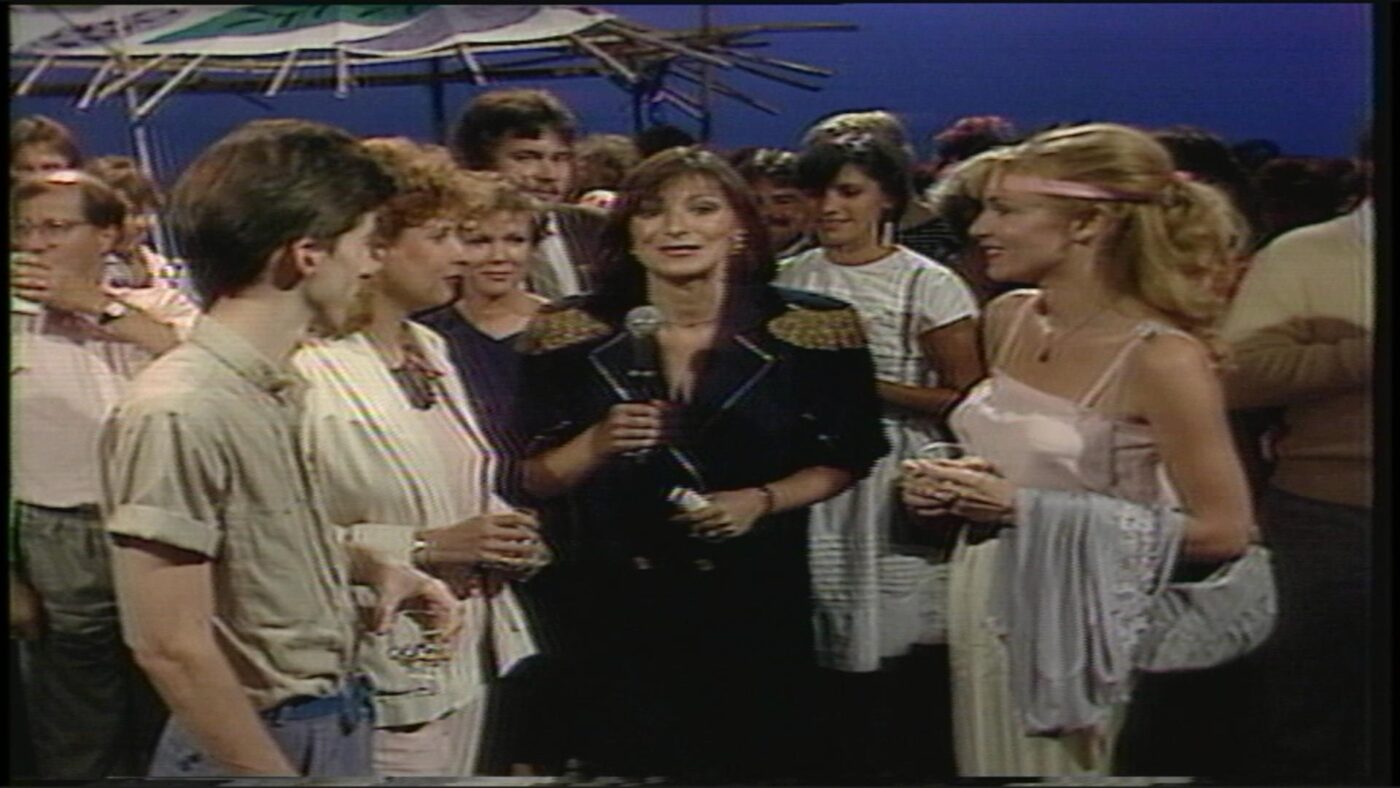
Still of Jeanne Beker hosting Rockflash.

Once the music – and by extension, the hosts – left MuchMusic, it fell off the pop cultural radar. So, last summer, when Bell Media announced in a press release its upcoming relaunch of MuchMusic via a partnership with TikTok to deliver content that “speaks directly to Gen Z and younger millennials,” there was a bit of a kerfuffle over the news. In particular, gen Xers waxed nostalgic over MuchMusic programs like The Wedge and French Kiss, as well as VJs such as George Stroumboulopoulos and Sook-Yin Lee.
According to the Bell Media press release, TikTok will become the exclusive home to iconic MuchMusic series Video On Trial (where a panel of experts, usually comedians or entertainment reporters, poked fun at music videos), Intimate and Interactive (small-scale live performances where a studio audience got a chance to listen to intimate conversations with musical artists) and MuchMusic Spotlight (a biographical show that highlighted an artist’s career).

MuchMusic founder and Canadian media executive Moses Znaimer.

For industry folk, the immediacy and perceived authenticity of TikTok is reminiscent of MuchMusic’s scrappy, upstart beginnings.
“Oh, you could never call MuchMusic a studio — that was, like, illegal,” Lee says with a grin during a Zoom interview. “It’s called ‘The Environment.’ It was a living, breathing organism.
“[MuchMusic founder and Canadian media executive Moses Znaimer] got rid of all the walls. We talked to each other. He was all about making stuff up in the moment.”
Born and raised in North Vancouver, Lee never aspired to move to Toronto to become a VJ. She’d grown up in a strict first-generation Chinese-Canadian household, and ran away from school and home when she was 15. Lee was making alternative music and films, and squatting in Reid Island, when a producer friend asked if he could use some of her work as part of a demo tape to send to Znaimer. The next thing Lee knew, she was on a call with Znaimer who was “curious to see what [Lee] could do” on TV. When he offered her a job in Toronto, Lee hesitated. She wanted complete freedom in her creative process.
“If it has my name under it, and I’m reading somebody else’s words as me, it would be hell,” Lee explains. “[Znaimer] said, ‘That’s not what I want. All I want is you to be you.’”
Lee, who took it upon herself to borrow equipment from the station to record her personal experiences across Toronto during off-hours, was encouraged to showcase her point-of-view.
“His whole legacy is [that] he had a real eye for finding interesting people that captured his interest and imagination, showed they have curiosity and some kind of talent, which he appreciated,” she continues. “He loved it if they were, you know, completely green.”
Former VJ Hannah Sung, who worked at MuchMusic from 2002 to 2005, had a similar experience. “I guess they saw me as someone who had a voice, or wanted to develop one anyway,” she says, adding that she grew up watching Lee on the channel.
In his book Is This Live?: Inside the Wild Early Years of MuchMusic, Christopher Ward, one of MuchMusic’s first two VJs, describes the “studio” as a place with no wardrobe, no script, no rehearsal, no pre-record, no fix-in-the-mix, no wake-up call, no stylist, no daycare and no free lunch. Still, to millions of viewers, MuchMusic was the heartbeat of pop culture in Canada.
Ward had been hired in 1983 by John Martin, the Canadian broadcaster credited with creating the weekly Citytv music show The New Music, which was inspired partly by Rolling Stone magazine. With the success of The New Music, which ran from 1979 to 2008, Martin was able to convince Citytv co-founder Znaimer to start a 24-hour music channel that would be a kind-of-but-not-really Canadian equivalent to MTV. It eventually became known as MuchMusic.
Speaking over Zoom from his Santa Monica home, Ward, 72, says MuchMusic had a winning formula that’s hard to pin down.
“It’s many things — some of which can be planned, some which can be explained and a lot of which just happened,” he says with a chuckle. The programming evolved “by virtue of who the participants were [and] the ridiculous amount of freedom that they gave us to make television. I was working with producers who were 21, 22, fresh out of Centennial College. But they were super bright and really passionate about music and about television. And we had a blast.”

From left to right: Former MuchMusic VJs Christopher Ward, Denise Donlon, Michael Williams and Erica Ehm.

BREAKING BARRIERS
In fact, Citytv and MuchMusic’s formula for breaking down the walls between the studio audience and the people making the shows was considered so groundbreaking that it’s been studied and replicated around the world, according to Humber College cultural studies professor Naveen Joshi.
When Joshi’s parents emigrated from Punjab, India, to Canada in the 1970s, they ended up in South Porcupine, Ont. (a 10-minute drive east of Timmins) because his father got a job in the mining industry there. Like Sung’s experience watching Lee on MuchMusic, the channel instilled Joshi with a sense of belonging as a brown kid growing up in “a sea of whiteness,” even though he lived an eight-hour drive north of Toronto.
“I still remember when it became a standard in the basic cable package. MuchMusic became this kind of way out because it was a way for seeing people who are not white on the screen,” the 43-year-old explains. “It was a way for me — diagnosing this later on — [to be] part of this imagined community I had never seen before.”
“Like, I could talk about these events that happened in Toronto when I was never even there. But I saw it on TV,” Joshi continues, adding that the channel helped him cultivate his love for hip-hop music. “I remember Soul in the City, I remember Rap City, I remember Extended Mix. I remember Electric Circus later because hip-hop artists performed there.”
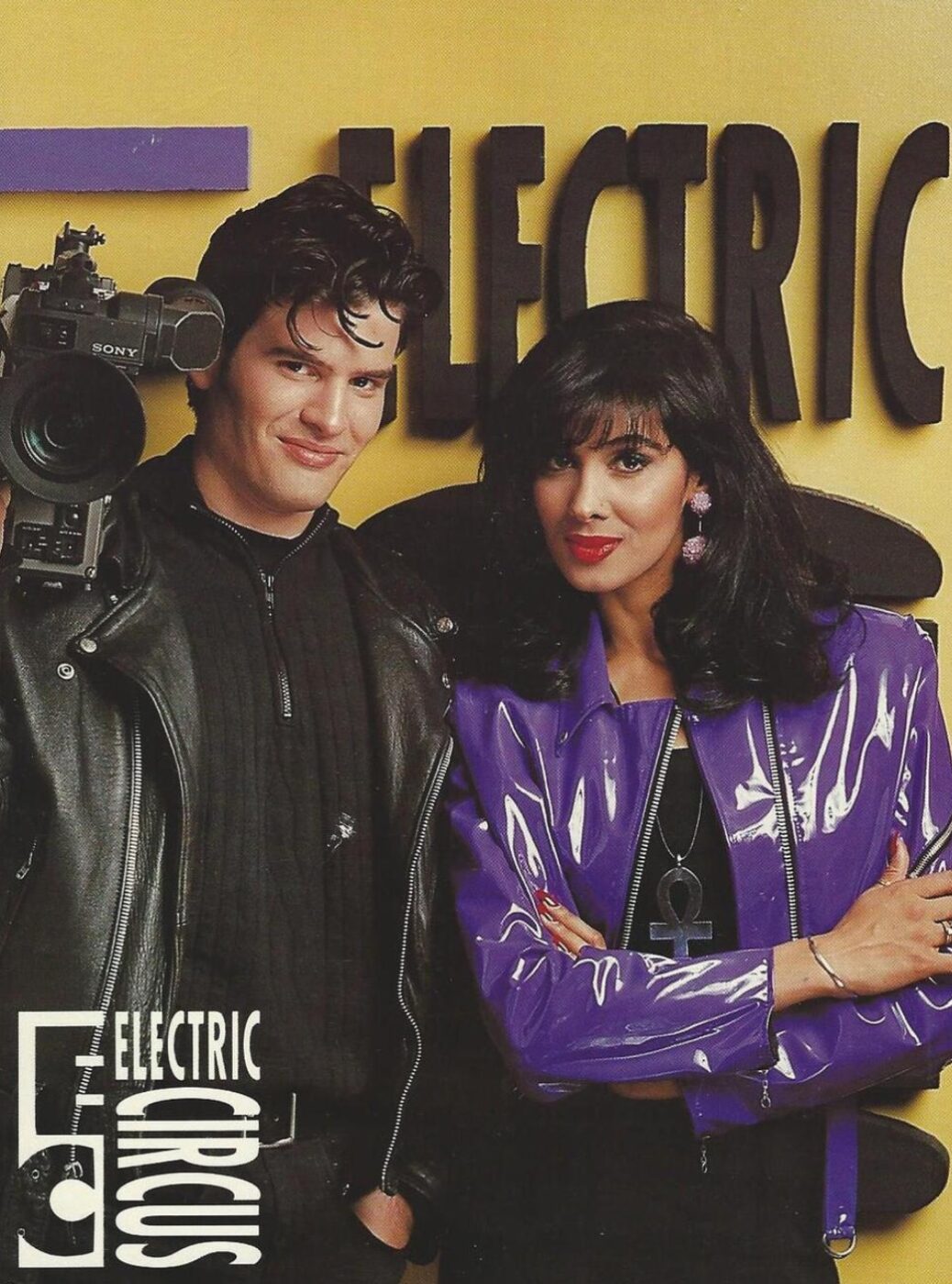
Monika Deol and George Lagogianes, co-hosts of Electric Circus, in the early '90s.

Meanwhile, on the other side of Ontario in St. Catharines, former VJ Jennifer Hollett, 46, grew up watching MuchMusic at her friend’s house since her own family didn’t have cable television. The channel combined Hollett’s deep interest in a range of musical genres, from boy bands and punk rock to hip-hop, as well as her burgeoning interest in political issues. MuchMusic started to include activism-oriented programming in 1997 after Denise Donlon took over as its vice-president and general manager. The channel aired AIDS PSAs, election coverage and the Kumbaya Festival, an annual music and arts festival that raised money for HIV/AIDS charities.
Hollett, who worked at MuchMusic from 2002 to 2005, eventually got to see the MuchMusic building in person during trips to Toronto.
“I remember being outside those windows and Queen and John for Marky Mark — that’s one memory. I had a love for Marky Mark and the Funky Bunch,” says Hollett, now executive director of The Walrus. She was also a part of a b-girl crew called shebang!, which once performed on MuchMusic’s Electric Circus, a live dance music show originally hosted by Monika Deol and Michael Williams that aired from 1988 to 2003.
“I don’t know how proud of this I should be but I even snuck into the MuchMusic Video Awards a few times,” she adds with a laugh. Although Hollett had previously worked for Sony Music Canada, it was hard to get a ticket to the annual awards show that literally brought music and artists to Toronto’s streets. “I was once actually, formally, an extra in the background…kind of like seat-fillers except there aren’t any seats at the MMVAs.
“I remember, at the time, it was one of the last performances of A Tribe Called Quest.”
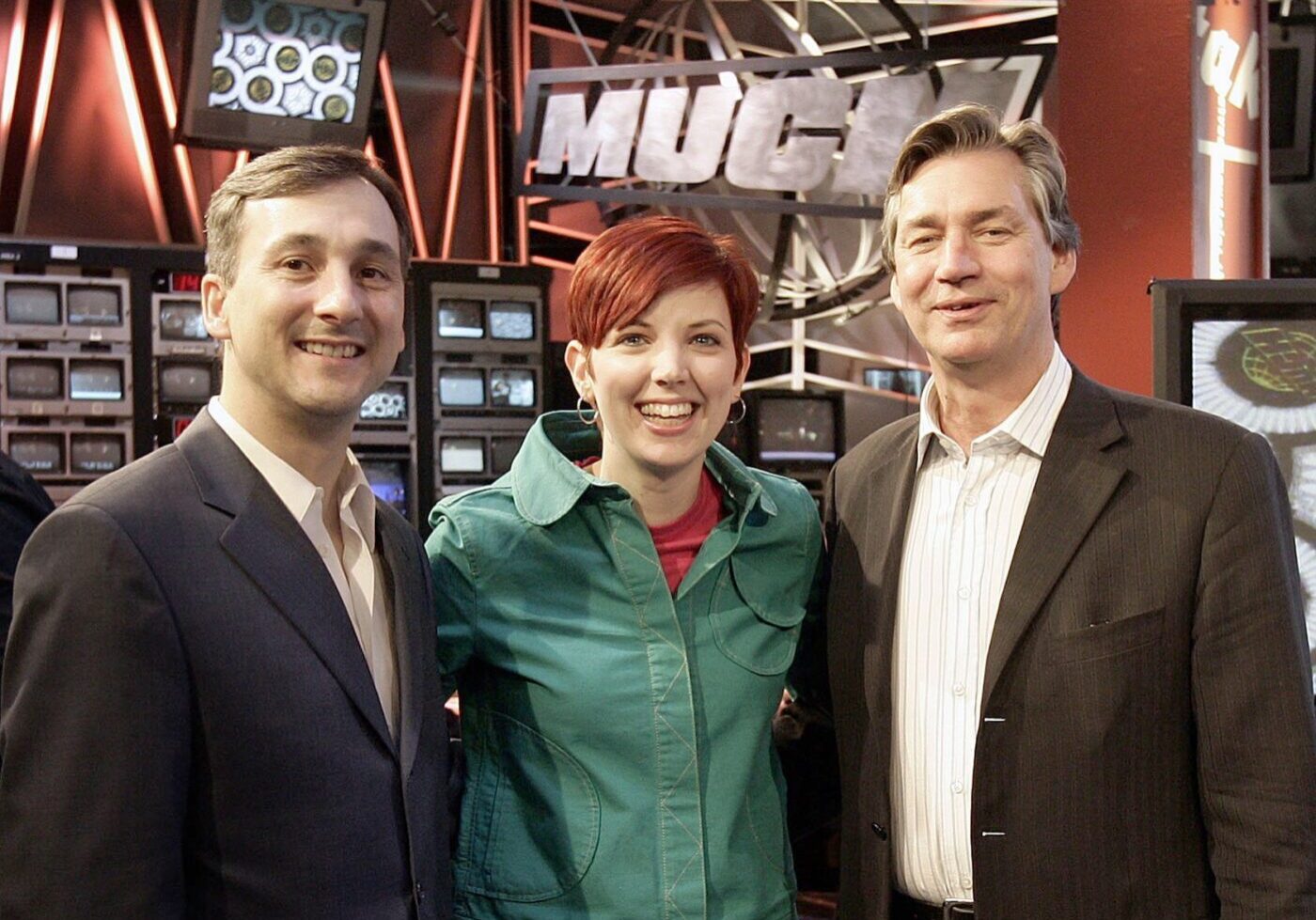
Former New Brunswick Premier Bernard Lord (left) and former Manitoba Premier Gary Doer (right) with former MuchMusic VJ Jennifer Hollett.

DEFINING A CITY
That era of MuchMusic invited you in to be a part of it, according to Justin Stayshyn, former member of Canadian indie group The Hidden Cameras and now a digital producer and writer for the Ontario NDP caucus.
Although Stayshyn, who says he’s in his 40s, grew up in Hamilton, he was keenly aware of the space that the MuchMusic building occupied both physically and metaphorically as the “epitome of Toronto cool.” In 1999, Stayshyn got involved in Toronto’s indie music scene. Then, two years later in 2001, he moved into an apartment across the street that overlooked the MuchMusic building.
“[MuchMusic] became like a neighbour,” he explains, adding that the MMVAs felt like his neighour was having a party. “It was always fun to watch everyone run up the back of the bars and alleyways.”
Since the MMVAs always happened on Sundays, Saturday was slated for soundchecks. If Nickelback was playing, Stayshyn and his musical colleagues would stay away from their apartment. On the other hand, they appreciated the pandemonium caused by the Beastie Boys. Although his own band never got any play on the MuchMusic channel, musical friends like Arcade Fire got a chance to perform at Queen and John.

The Smashing Pumpkins performing at the 1998 MMVAs.

“There were some moments where there’s some crossover, and it was always welcome. It was never like: We’re too cool for this,” Stayshyn says, adding that MuchMusic was a welcoming space. “You had Speaker’s Corner, which was inviting you to go in. Then you had Electric Circus, again, which was inviting people to go dancing. Those windows became a symbol of the invitation — like, this is a building that is about everybody.”
Former VJ Sung, 44, watched MuchMusic as a kid in her suburban Scarborough home, but didn’t always feel that its headquarters were accessible.
“I used to watch Toronto Rocks on Citytv and Video Hits on CBC, but MuchMusic was different because it was looser,” says Sung, now co-founder of the Media Girlfriends podcast and author of the At The End Of The Day newsletter, in a phone interview.
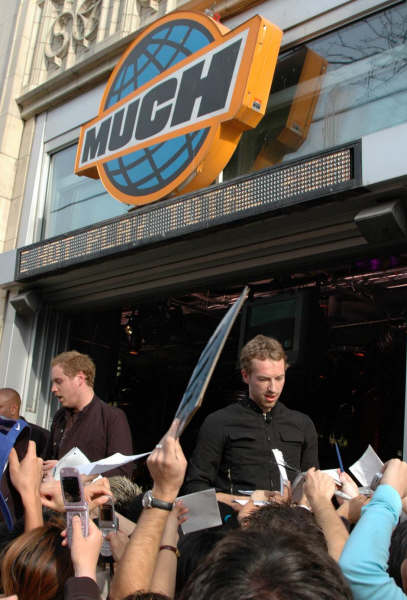
Coldplay signing autographs for fans waiting outside MuchMusic HQ on Queen Street West.
📸: Provided by bell media.
But the channel “may as well have been on Mars” given that she grew up in Toronto’s Malvern and West Hill neighbourhoods. As someone from a suburb far removed from downtown, Sung says she felt there was a major geographical divide between her Scarborough home and Muchmusic HQ.
“It didn’t really register that it was a place that was accessible until I got to high school, and I was taking the TTC by myself, and I was wandering through Queen Street West a lot at that time,” she explains. “But again, it didn’t feel like a world that I could in any way enter or inhabit.
“When I started taking trips down to just hang out, I had my favourite places, and MuchMusic wasn’t really one of them. I didn’t relate to the fans who stood at the window. I actually really avoided that kind of thing….In my teen years, the music that I liked wasn’t popular enough.”
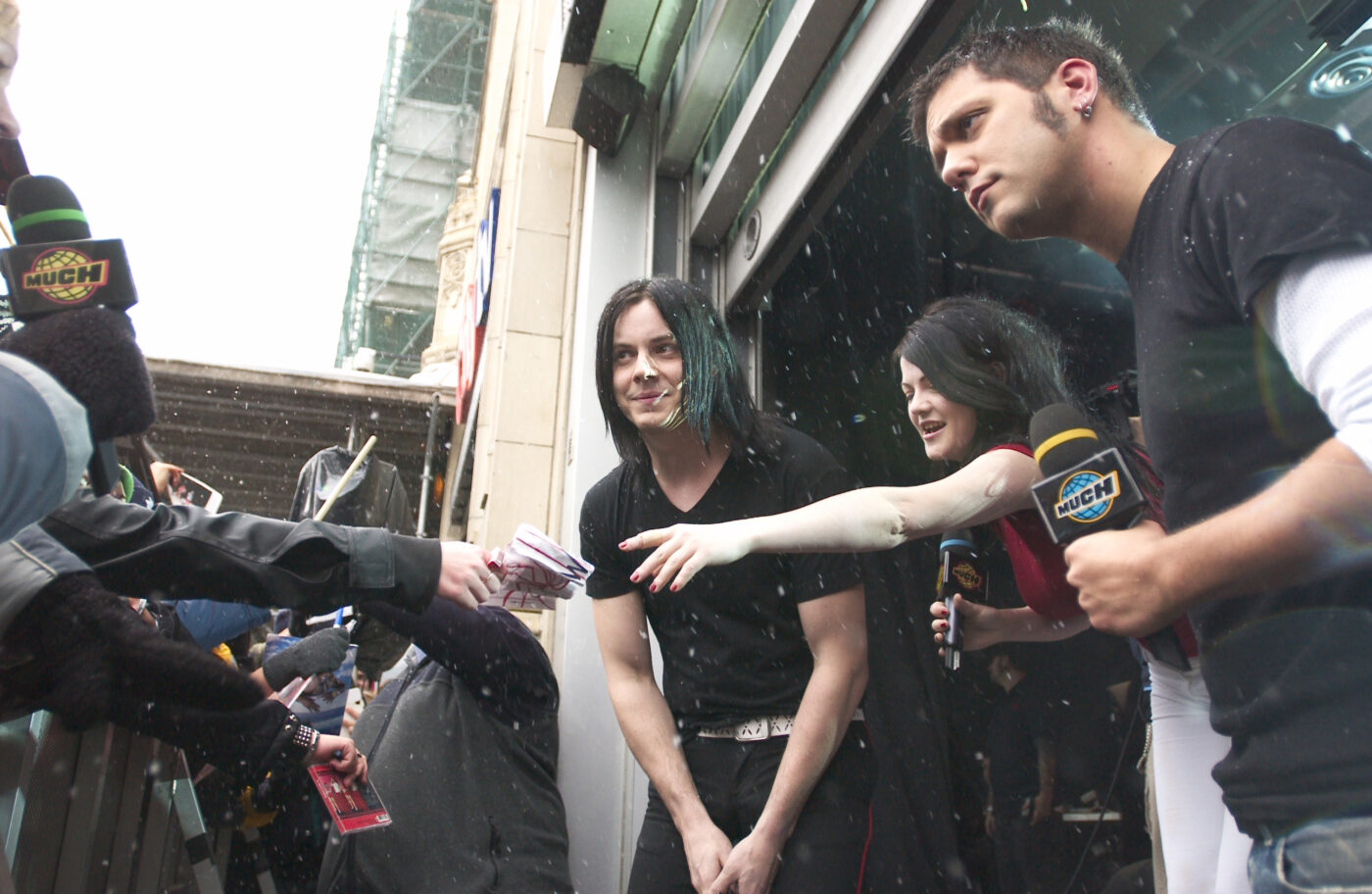
The White Stripes greeting fans outside MuchMusic HQ, alongside former VJ George Stroumboulopoulos.

DOWNTOWN OR BUST
MuchMusic’s headquarters in the Citytv building was “very much a part of the mythology” of Toronto’s cityscape, says Shawn Micallef, a columnist, author and frequent commentator on local urban issues, geography and culture.
According to Micallef, 47, the city that was once known as Toronto the Good retained its puritanical roots until the late 1960s, though there were always thriving subcultures within the city. Toronto was an important stop on the jazz circuit in the ‘50s, and home to a significant punk rock and rave scene in the ‘80s and ‘90s, respectively.
In the late ‘60s and through to the ‘70s, the city saw an influx of Vietnam War draft dodgers, Montrealers looking to avoid the Quebec secessionist wave, and large groups of immigrants who benefited from loosened immigration policies that resulted from the Immigration Act of 1976.
“People could find their community here. So on all these fronts, [Toronto] just started really booming economically, and that often leads to a cultural boom because some people like to make money. But there are always people who want to make culture and then consume culture,” Micallef explains in a phone interview.
Although creating culture is an abstract concept for many people, MuchMusic demystified that process.
“Often, the idea of TV [is that it] just comes out of the air. But MuchMusic was geographically on Queen Street West, which was the coolest street in Canada,” says Micallef. “With apologies to Montreal and Vancouver and Halifax, etc.
“It was the place to be, and still had the mystic-ness of the 1980s and into the ‘90s arts scene that lived there. So it was a very hip place to be located. And as the lore goes, Moses Znaimer kind of invented the idea of storefront television here in Toronto, where you could walk by and see the shows being recorded….It was the social medium before social media. So it was really revolutionary.”

Sadé Powell, a new VJ for the rebooted MuchMusic.

MUCH REBOOTED
By the mid-2000s, however, things began to change.
Znaimer left Citytv in 2003, media consolidation eventually saw MuchMusic becoming part of Bell Media, and the onslaught of digital and social media started to be reflected in MuchMusic’s lineup. The channel had been increasingly programming reality TV and other non-music shows. So, by 2019, MuchMusic — which by then had been rebranded simply as Much — cut down airtime for music videos to a single hour on weekdays.
“I would look at the ratings as a VJ who produced shows, and I was amazed that a second- or third-run show from MTV would outperform us,” says Hollett, describing the time around her own departure from MuchMusic in 2005.
The rise of YouTube and tabloid magazine culture in the mid-2000s also played a role in MuchMusic’s demise, according to Sung.
“We went from doing interviews with bands to hourly updates on Britney Spears shaving her head,” she says. “I felt so uncomfortable with all those changes. They were not unique to Much...it was our culture changing. But MuchMusic was a part of that.”
For Joshi, easier access to a wider range of music on his cable channel package had him flipping the channels.
“Even someone like myself, who swore by MuchMusic — once BET became standard in cable packages, I’m watching The Basement, right?” he says. “You start to see more selections, more clutter.
“And then once the internet came, we were getting new stuff all the time.”
At the same time these changes were happening in the media industry, Stayshyn says, MuchMusic’s laissez-faire ethos was disappearing and the building wasn’t so welcoming anymore.
“I remember when the branding changed when [Bell Media] came in, and looking up, and suddenly there was like a balcony there…and it’s high up. You can’t reach there. It’s somebody looking down on you — and that epitomized a shift,” he explains. “To further the metaphor…during the pandemic, they put up these boards. So it just lends itself more to a kind of sense of alienation.”
@much Which one do y’all think was the most on point?! ???????? #celebritylookalike #muchmusic #vjs ♬ original sound - Niana Guerrero
In July 2021, Bell Media and TikTok relaunched MuchMusic. The announcement, which generated some buzz in Canada’s media industry, said their goal was to reinvigorate the iconic youth brand with a content-driven, digital-first strategy, and by featuring new VJs and popular digital creators.
MuchMusic’s TikTok strategy owes a lot to its precursor BarDown, a TSN property that combines sports stories and pop culture with original content created for a YouTube audience, such as quizzes, vlogs and a video version of the BarDown podcast. The idea is to meet a new, younger audience on their preferred platform, while keeping an eye on MuchMusic’s past as a Canadian cultural icon, according to David Krikst, TSN’s director of audience development and editorial strategy.
“We wanted to put out music for the new generation of music fans, and we wanted to do that on a platform they were enjoying content on,” explains Krikst, 45, who also oversees social media content creation for BarDown and MuchMusic. BarDown’s success with creating content on different platforms and speaking to its audience in a relatable way inspired MuchMusic’s revival on TikTok, he adds. It was a natural fit, given how much music is tied to the fast-growing platform’s programming.
“[It] has so many incredible features around editing and creating content that it’s a [space for young people] to express their creativity, as well as come together as a community,” which were the hallmarks of the original MuchMusic, Krikst says.
All the new MuchMusic VJs are Toronto natives, so they’ll add that local perspective into the content they create, he adds. Due to COVID restrictions, however, TikTok videos created by the VJs were primarily shot in their homes. But that has changed since mandates were lifted in March.
“I don’t think there are borders in music like there used to be. I think you look at some of the top artists in the world, and they are Canadian,” Krikst says. “That being said, the footprint that Much had in Toronto — in interacting with the community locally — was definitely a part of its legacy that we’d like to bring back, if possible.”
Kwesi Kwarko-Fosu, 27, one of the new crop of VJs, grew up on MuchMusic so he considers himself an “old head.”
“I used to record Rap City on a video camera I had back in the days,” he says with a laugh.
MuchMusic was one of the few television channels, aside from the news, that was relevant to Kwarko-Fosu as a teen who grew up in North York and later attended University of Toronto’s downtown St. George campus. Several months after he began creating TikTok videos in March 2020, Kwarko-Fosu started documenting Toronto and his travels to various parts of the city; in May 2020, one of his videos on former Raptor Kyle Lowry “blew up.” With a following of more than 81,000 followers and 3.8 million likes and counting, he caught the attention of Bell Media.
Kwarko-Fosu adds that reflecting Toronto in the new MuchMusic is important, but so is showcasing the broader Canadian music scene to a global audience. A large part of its TikTok viewership is American, presenting the VJs with a unique opportunity to highlight Canadian artists from across the country to new audiences around the world.
As far as the type of TikTok videos they’re planning for the future, Kwarko-Fosu says he and the other MuchMusic VJs are “taking baby steps.” They’re still in the early stages of figuring out how to best reflect Toronto and other parts of Canada, while also developing their own individual voices as VJs on TikTok and the creative dynamic of the team as a whole.
As far as Steve Kerzner, better known as Ed the Sock, is concerned, however, Bell Media isn’t trying to revive MuchMusic as much as it’s trying to create a new brand for an audience that has no connection to the original programming whatsoever.
“They’re attempting to redefine what MuchMusic means for Gen Z, and I wish them luck,” he says in a Zoom interview. “I don’t think it’s possible to recreate the original completely.”
On a blustery Sunday afternoon, Kerzner stands at the intersection of Yonge and Dundas Streets, recording video vignettes to air on his YouTube Channel NewMusicNation.ca. As he shoots, people stop by to chat and take pictures. They remember the TV personality for his hilariously cantankerous segments on MuchMusic.
“What you don’t see is how long it takes in between each shot because people want pictures, right? We’ve had bicycle cops, and even a cop in a cruiser pull over and want to get a picture with Ed,” Kerzner says.
If Bell Media wants to truly tap into the free-spiritedness that was a hallmark of MuchMusic past, it needs to “get out and interact with people,” he adds. That’s part of his mandate with NewMusicNation.ca — to reflect the diversity of a city like Toronto that’s expanded way outside the downtown core.
“We don’t have wires anymore, and we don’t have to have giant cameras or expensive lighting. That’s all contained in your phone,” Kerzner explains. “We’ve got VJs we’re training across the country, and they get to go out and show colourful spots of their city.”
Despite the potential to truly be inclusive, Bell Media faces an uphill battle. Unlike in the past, there’s no collective viewer experience, Kerzner points out. Today’s fractured media landscape means that digital creators may have millions of subscribers, but the general population may never hear about them.
Although Hollett applauds the attempt, she says Bell Media’s strategy misses out on a tailor-made audience that actually remembers what MuchMusic once stood for, but who may not necessarily be on TikTok. “To me, the bits between music videos — what we called throws — feels like those were early TikToks. So there is a space for Much on TikTok.”
But the demographic with a real emotional connection to the brand isn’t on TikTok, Hollett adds, though she acknowledges that could change given how quickly the platform is growing. “Time will tell if they are able to [build a new audience of young viewers]. But from what I’m seeing, the TikTok numbers and the social media numbers aren’t that high [for individual video views],” she explains.
For her part, Lee occasionally uses TikTok, but says it’s not her go-to social platform.
“There [are] only so many hours of the day,” she adds. “There's a lot of people online. There's a lot of content, you know?”
As far as MuchMusic’s relationship to the city is concerned, geography matters, according to Micallef.
“As things become more and more ephemeral, like working from home — for those who can do that — and [people are] not being tethered to any one physical place, the places that are physically rooted have a lot of power to them,” he explains. “Especially places that pull together people from a whole bunch of different backgrounds.”
If the reimagined version of MuchMusic is able to give us a sense of collective belonging — real or imagined — in Toronto, it could become a relevant part of our lives again, according to Joshi.
“This is where the importance of live events and reflecting the things that are going on in the city comes in,” says Joshi. “I think a physical hub is important. Or even trying to re-establish street corners the way that MuchMusic did.
“But if the intention of Bell Media is just to get in on the game, then they don’t really have interest in that. If they don’t have an interest in re-establishing MuchMusic like a cultural force in the city, the city will move on.”
Here's your chance to support the only independent, hyperlocal news outlet dedicated to serving gen Zs, millennials and other underserved communities in Toronto. Donate now to support The Green Line.
PART 3
Defining Toronto's identity through music: How to support local artists who shape our culture
A community event and Story Circle hosted by The Green Line.
About the Event
MuchMusic helped put Toronto on the map. Canada's national music channel was the place to see and possibly touch your favourite musical artists, but it faded out of public memory by 2014. Last year, parent company Bell Media relaunched MuchMusic. But can the reboot reflect our city's new identity as a global urban centre? At this Action Journey event, The Green Line is inviting community members like you to brainstorm ways to motivate their fellow Torontonians to support the local music scene, and help solidify the city's identity as an emerging creative hub. RSVP now for our virtual event.
Events are an essential part of our Action Journey. We want to empower Torontonians to take action on the issues they learn about in The Green Line — so what better way to do that than by bringing people together? From community members to industry leaders, anyone in Toronto who’s invested in discussing and solving the problems explored in our features is invited to attend. All ages are welcome unless otherwise indicated. Our only guidelines? Be present. Listen. Be kind and courteous. Respect everyone’s privacy. Hate speech and bullying are absolutely not tolerated. At the end of the day, if you had fun and feel inspired after our events, then The Green Line team will have accomplished what we set out to do. Any questions? Contact Us.

APARITA
BHANDARI

SHAWN
MICALLEF
Shawn Micallef is the author of Frontier City: Toronto on the Verge of Greatness, Stroll: Psychogeographic Walking Tours of Toronto and The Trouble With Brunch: Work, Class and the Pursuit of Leisure. In 2002, while a resident at the Canadian Film Centre’s Media Lab, he co-founded [murmur], a location-based mobile phone documentary project that spread to more than 25 cities globally.

NAVEEN
JOSHI
Dr. Naveen Joshi is a professor of cultural studies at Humber College where he teaches courses at the intersection of race, gender, popular culture and social networks. He's designed and will be running Humber College's first ever hip-hop studies course. Dr. Joshi completed his master’s in popular culture at Brock University and his PhD in communication and culture at York University.

JOANNA
MOHAMMED
A.K.A. APHROSE
APHROSE a.k.a. Joanna Mohammed is an R&B and indie soul artist from Toronto who’s known for her powerful, soaring vocal stylings. Joanna has worked with industry heavyweights, including Daniel Caesar, Jessie Reyez, Chantal Kreviazuk and Raine Maida of Our Lady Peace. Her music has also been featured on CBC’s Here & Now. She is currently working on her sophomore album, which is slated for release in fall 2022.
PART 4
Showcasing the City:
Stages for Toronto's musical talent
Event Overview
See what you missed
from our latest event.
Our community members brainstormed ways to motivate their fellow Torontonians to support the local music scene, and help solidify the city's identity as an emerging creative hub. Compiled by Shaki Sutharsan.

Cultural studies professor Naveen Joshi at The Green Line's May Action Journey event, showing his favourite cassettes and CDs, which he discovered through MuchMusic.

Singer APHROSE a.k.a. Joanna Mohammed describes how she supports Toronto's local music scene as an indie artist herself.

Adele Lukusa talks about her music-listening habits, and how she discovers local Toronto artists.

Arts journalist Aparita Bhandari brainstorms ways to support Toronto's local music scene.
SOLUTIONS
ACTIONS
Do something about the problems that
impact you and your communities.
Inform Toronto’s
Music Culture
Complete this survey as part of the City of Toronto’s cultural development review to advocate for ways to support our local music scene.
Join Our
Community
Continue the conversation with other Green Line community members.
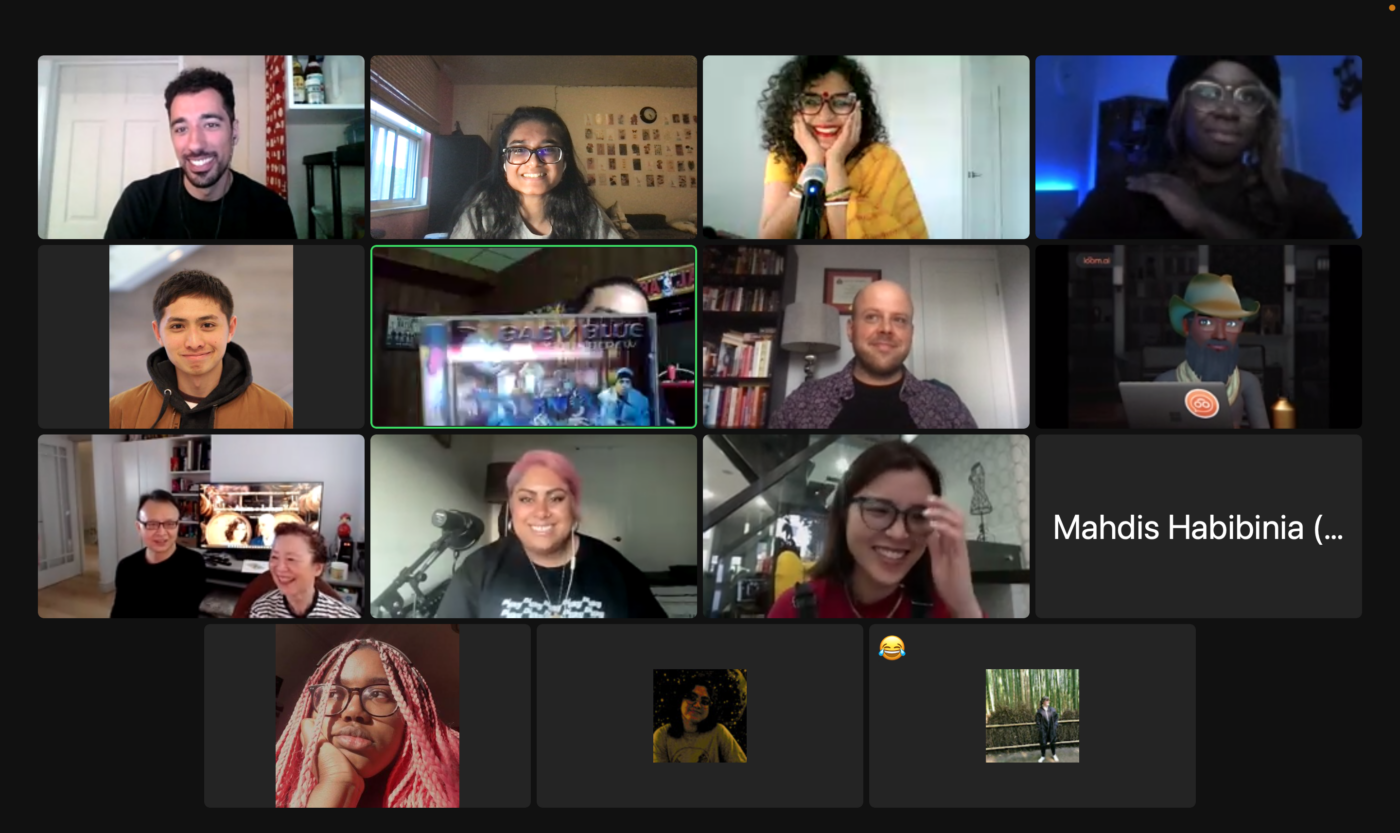
ATTENDEES REACT TO NAVEEN JOSHI'S MUCHMUSIC COLLECTION.
Supporting The Green Line means supporting Toronto. Join our membership program today, so you can redefine our city as you see it.

